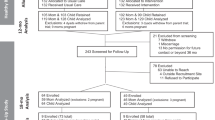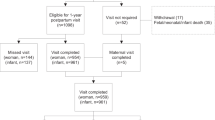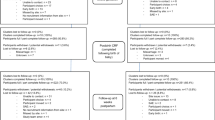Abstract
OBJECTIVES: (1) To describe the relative importance of gestational weight gain, postpartum exercise, food intake and breastfeeding to weight change from early pregnancy to 1 y postpartum; and (2) to identify subgroups of women at greatest risk for major weight gain surrounding childbearing.
DESIGN: A prospective cohort study of women who registered for obstetrical care in a hospital and primary care clinic system serving a 10 county area of upstate New York.
SUBJECTS: A total of 540 healthy adult women who gave birth to full-term singleton infants.
MEASUREMENTS: Sociodemographic characteristics, exercise, food-related behaviors and breastfeeding were assessed using the medical record and a mailed questionnaire. Body weight was measured at prenatal visits and 1 y postpartum. Weight retained and major weight gain (4.55 kg) at 1 y postpartum were the main outcomes.
ANALYSIS: Linear and logistic regression analyses were conducted.
RESULTS: Women were on average 1.51±5.95 kg heavier at 1 y postpartum than they were in early pregnancy. Nearly 25% of women experienced a major weight gain of 4.55 kg or more at 1 y postpartum. Gestational weight gain, exercise frequency, change in food intake and breastfeeding were each significantly related to postpartum weight retention. With the exception of breastfeeding, all of these factors were also associated with major weight gain. Women under 20 y or over 40 y at delivery, and single women retained significantly more weight. Lower income women with gestational weight gains above the Institute of Medicine (IOM) range retained 3.73 kg more than lower income women who gained within the range. They were also 4.7 times more likely to experience major weight gain with childbearing. The impact of exceeding the IOM gestational weight gain guidelines was three times greater in lower income women than it was in higher income women.
CONCLUSION: Gestational weight gain, postpartum exercise frequency, and food intake are significantly associated with weight change from early pregnancy to 1 y postpartum and major weight gain with childbearing. Lower income women who gain more weight in pregnancy than the IOM recommends are at high risk for major weight gain with childbearing.
This is a preview of subscription content, access via your institution
Access options
Subscribe to this journal
Receive 12 print issues and online access
$259.00 per year
only $21.58 per issue
Buy this article
- Purchase on Springer Link
- Instant access to full article PDF
Prices may be subject to local taxes which are calculated during checkout



Similar content being viewed by others
References
Must A, Spando J & Coakley EH . The disease burden associated with overweight and obesity. JAMA 1999; 282: 1523–1529.
Rookus M, Rokebrand P, Burema J & Deurenberg P . The effect of pregnancy on the body mass index 9 months postpartum in 49 women. Int J Obes 1987; 11: 609–618.
Wolfe WS, Sobal J, Olson CM, Frongillo EA Jr & Williamson DF . Parity-associated weight gain and its modification by sociodemographic and behavioral factors: a prospective analysis in US women. Int J Obes Relat Metab Disord 1997; 21: 802–810.
Williamson DF, Madans J, Pamuk E, Flegal M, Kendrick JS & Serdula MK . A prospective study of childbearing and 10-year weight gain in US white women 25 to 45 years of age. Int J Obes Relat Metab Disord 1994; 18: 834–838.
Smith DE, Lewis CE, Caveny JL, Perkins LL, Burke GL & Bild DE . Longitudinal changes in adiposity associated with pregnancy. The CARDIA Study. Coronary Artery Risk Development in Young Adults Study. JAMA 1994; 271: 1747–1751.
Schauberger CS, Rooney BL & Brimer LM . Factors that influence weight loss in the puerperium. Obstet Gynecol 1992; 79: 424–429.
Ohlin A & Rossner S . Maternal body weight development after pregnancy. Int J Obes 1990; 14: 159–173.
Greene GW, Smiciklas-Wright H, Scholl TO & Karp RJ . Postpartum weight change: how much of the weight gained in pregnancy will be lost after delivery. Obstet Gynecol 1988; 71: 701–707.
Keppel KG & Taffel SM . Pregnancy-related weight gain and retention: Implications of the 1990 Institute of Medicine guidelines. Am J Public Health 1993; 83: 1100–1103.
Gunderson EP & Abrams B . Epidemiology of gestational weight gain and body weight changes after pregnancy. Epidemiol Rev 1999; 21: 261–275.
Boardley DJ, Sargent RG, Coker AL, Hussey JR & Sharpe PA . The relationship between diet, activity, and other factors, and postpartum weight change by race. Obstet Gynecol 1995; 86: 834–838.
Muscati SK, Gray-Donald K & Koski KG . Timing of weight gain during pregnancy: promoting fetal growth and minimizing maternal weight retention. Int J Obes Relat Metab Disord 1996; 20: 526–532.
Scholl TO, Hediger ML, Schall JI, Ances IG & Smith WK . Gestational weight gain, pregnancy outcome, and postpartum weight retention. Obstet Gynecol 1995; 86: 423–427.
Parker JD & Abrams B . Differences in postpartum weight retention between black and white mothers. Obstet Gynecol 1993; 81: 768–774.
Sampselle CM, Seng J, Yeo S, Killion C & Oakley D . Physical activity and postpartum well-being. J Gynecol Obstet Nurs 1999; 28: 41–49.
Ohlin A & Rossner S . Trends in eating patterns, physical activity and sociodemographic factors in relation to postpartum body weight development. Br J Nutr 1994; 71: 457–470.
Johnston EM . Weight changes during pregnancy and the postpartum period. Prog Food Nutr Sci 1991; 15: 117–157.
Hinton PS & Olson CM . Predictors of pregnancy-associated change in physical activity in a rural white population. Matern Child Health J 2001; 5: 7–14.
Kendall A, Olson CM & Frongillo EA Jr . Evaluation of psychosocial measures for understanding weight-related behaviors in pregnant women. Ann Behav Med 2001; 23: 50–58.
Olson CM & Strawderman MS . Modifiable behavioral factors in a biopsychosocial model predict inadequate and excessive gestational weight gain. J Am Diet Assoc, (in press).
Institute of Medicine . Nutrition during pregnancy. Part I, Weight gain, National Academy Press: Washington, DC; 1990; p 10
Godin G & Shephard RJ . A simple method to assess exercise behavior in the community. Can J Appl Sport Sci 1985; 10: 141–146.
Jacobs DR, Ainsworth BD, Hartman TJ & Leon AS . A simultaneous evaluation of 10 commonly used physical activity questionnaires. Med Sci Sports Exerc 1993; 25: 81–91.
Pereira MA, FitzGerald SJ, Gregg EA, Joswiak ML, Ryan WJ & Suminski RR et al . A collection of physical activity questionnaires for health-related research. Med Sci Sports Exerc 1997; 29 (Suppl 6): S36–S38.
Ainsworth BE, Haskell WL, Leon AS, Jacobs DR Jr, Montoye HJ & Sallis JF et al . Compendium of physical activities: classification of energy costs of human physical activities. Med Sci Sports Exerc 1993; 25: 71–80.
Willlet WC, Sampson L & Stampfer MJ . Reproducibility and validity of a semiquantitative food frequency questionnaire. Am J Epidemiol 1985; 122: 51–65.
Brown JE, Buzzard M, Jacobs DR Jr, Hannan PJ, Kushi LH & Barosso GM et al . A food frequency questionnaire can detect pregnancy-related changes in diet. J Am Diet Assoc 1996; 96: 262–266.
Nagelkerke NJD . A note on a general definition of the coefficient of determination. Biometrika 1991; 78 (3): 691–692.
Selvin S & Abrams B . Analysing the relationship between maternal weight gain and birthweight: Exploration of four statistical issues. Paediatr Perinat Epidemiol 1996; 10: 220–224.
Parker JD & Abrams B . Prenatal weight gain advice: an examination of the recent prenatal weight gain recommendations of the Institute of Medicine. Obstet Gynecol 1992; 79: 664–669.
Cogswell ME, Serdula MK, Hungerford DW & Yip R . Gestational weight gain among average-weight and overweight women—what is excessive? Am J Obstet Gynecol 1995; 172: 705–712.
Schieve LA, Cogswell ME & Scanlon KS . An empiric evaluation of the Institute of Medicine's pregnancy weight gain guidelines by race. Obstet Gynecol 1998; 91: 878–884.
Pate RR, Pratt M, Blair SN, Haskell WL, Macera CA & Bouchard C et al . Physical activity and public health—a recommendation from the Centers for Disease Control and Prevention and the American College of Sports Medicine. JAMA 1995; 273: 402–407.
McCrory MA, Nommsen-Rivers LA, Mole PA, Lonnerdal B & Dewey KG . Randomized trial of the short-term effects of dieting compared with dieting and aerobic exercise on lactation performance. Am J Clin Nutr 1999; 69: 959–967.
Lovelady CA, Garner KE, Moreno LK & Williams JP . The effect of weight loss in overweight, lactating women on the growth of their infants. New Engl J Med 2000; 342: 449–453.
Dusdieker LB, Hemingway DL & Sturnbo PJ . Is milk production impaired by dieting during lactation. Am J Clin Nutr 1994; 59: 833–840.
Institute of Medicine . Nutrition during pregnancy and lactation: an implementation guide, National Academy Press: Washington, DC; 1992.
Taffel SM, Keppel KG & Jones GK . Medical advice on maternal weight gain and actual weight gain. Ann NY Acad Sci 1993; 678: 293–305.
Cogswell ME, Scanlon KS, Fein SB & Schieve LA . Medically advised, mother's personal target, and actual weight gain during pregnancy. Obstet Gynecol 1999; 94: 616–622.
Acknowledgements
This research was supported by NIH grants HD29549 and HD07331.
Author information
Authors and Affiliations
Corresponding author
Rights and permissions
About this article
Cite this article
Olson, C., Strawderman, M., Hinton, P. et al. Gestational weight gain and postpartum behaviors associated with weight change from early pregnancy to 1 y postpartum. Int J Obes 27, 117–127 (2003). https://doi.org/10.1038/sj.ijo.0802156
Received:
Revised:
Accepted:
Published:
Issue Date:
DOI: https://doi.org/10.1038/sj.ijo.0802156
Keywords
This article is cited by
-
I-PREGNO – prevention of unhealthy weight gain and psychosocial stress in families during pregnancy and postpartum using an mHealth enhanced intervention: a study protocol of two cluster randomized controlled trials
BMC Pregnancy and Childbirth (2023)
-
Impact of telelactation services on breastfeeding outcomes among Black and Latinx parents: protocol for the Tele-MILC randomized controlled trial
Trials (2022)
-
Improving Maternal Cardiovascular Health in Underserved Populations: a Narrative Review of Behavioral Intervention Trials Targeting Postpartum Weight Retention
Current Atherosclerosis Reports (2022)
-
Addressing Obesity in Preconception, Pregnancy, and Postpartum: A Review of the Literature
Current Obesity Reports (2022)
-
The experiences of postnatal women and healthcare professionals of a brief weight management intervention embedded within the national child immunisation programme
BMC Pregnancy and Childbirth (2021)



